How to Nail your next Technical Interview











You may be missing out on a 66.5% salary hike*













Interview Kickstart has enabled over 3500 engineers to uplevel.
Graphs are heavily used in real-life scenarios such as finding the shortest distance between two places on Google Maps, finding the nearest cab on Uber, and maintaining the user-friendly network on social networking sites like Facebook and LinkedIn. Software engineers use graphs in almost every aspect of their work, such as parsing a web page or understanding the DOM (document object model) structure, or implementing storage systems like GraphQL.
It’s no surprise that FAANG and other top tech companies often use graph-related questions to assess candidates for software engineering or software developer roles. If you’re preparing for your next tech interview, it is very important to learn graph-related concepts.
In this article, we’ll focus on Prim’s spanning tree algorithm:
A graph consists of some points and lines between them — it is a mathematical representation of a network that describes the relationship between the lines and points. A graph (G) is a set of vertices called nodes (v), which are connected by edges called links (e).
Thus, G = (v, e).
A tree is an undirected graph in which any two vertices are connected by exactly one path (a connected acyclic undirected graph). A spanning tree is a subset of Graph G, which has all the vertices covered with a minimum possible number of edges. And if the graph is a weighted graph, the weight of the spanning tree will be the sum of the weights of edges in the tree. Among all the spanning trees, the one which has the minimum weight is called the minimum spanning tree (MST).
For example: If the graph is:

Some possible spanning trees are:
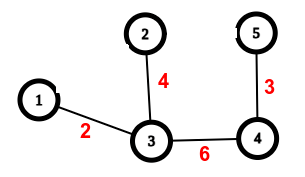
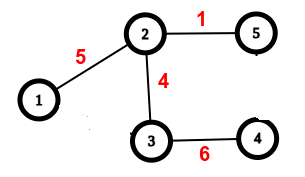
While the weights of the above spanning trees are 15 and 16 respectively, the minimum-weight spanning tree (minimum spanning tree) is 10.

Prim's algorithm is a greedy algorithm that finds the minimum spanning tree for a weighted undirected graph. The main idea behind this algorithm is that we want to take all the nodes of the graph and greedily connect them with minimum-weight edges. We start with an empty MST and keep track of two sets of nodes:
Each time, we will take a node with minimum weight from the first set and traverse other nodes connected to that node. In the end, all the required nodes will in the first set, and that will be our MST.
Here are the steps of the algorithm:
Let’s consider the following graph:

Let’s say the random node is 1. Then initialize:
visited = [false, false, false, false, false]
min_heap = {{0, 1}}
weight = [0, inf, inf, inf, inf]
Note: List is 1-based indexing.
Since the minimum-weight node that’s not visited is 1 (topmost value of the min_heap):
1. We will mark this node visited: visited = [true, false, false, false, false]
2. Next, we’ll remove the topmost value of min_heap. So, min_heap will become min_heap = {}
3. Next, we traverse to all the adjacent nodes of node 1:
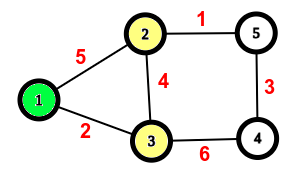
The minimum-weight node that’s not visited is 3 (topmost value of the min_heap). In other words, the minimum weight among yellow nodes.
1. We will make this node visited: visited = [true, false, true, false, false]
2. Now, we’ll remove the topmost value of min_heap. So, min_heap = {{5, 2}}
3. Next, we traverse to all the adjacent nodes of node 3:

The minimum-weight node that’s unvisited is 2 (topmost value of the min_heap).
1. We will make this node visited: visited = [true, true, true, false, false]
2. Now, we will remove the topmost value of the min_heap. So, min_heap = {{5, 2}, {6, 4}}
3. Next, we traverse to all the adjacent nodes of the node 2:
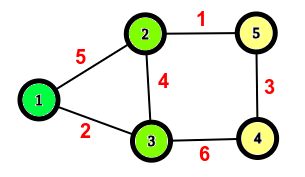
The minimum-weight node that’s unvisited is 5 (topmost value of the min_heap).
1. We will make this node visited: visited = [true, true, true, false, true]
2. Now, we remove the topmost value of the min_heap: min_heap = {{5, 2}, {6, 4}}
3. Next, we traverse to all the adjacent nodes of the node 5:
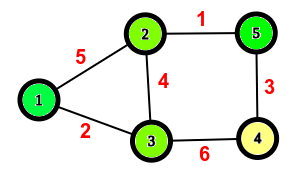
The minimum-weight node that is unvisited is 4 (topmost value of the min_heap):
1. We will make this node visited: visited = [true, true, true, true, true]
2. Now, remove the topmost value of the min_heap. So, min_heap = {{5, 2}, {6, 4}}
3. Next, we traverse to all the adjacent nodes of node 4:

Result: Now, all the nodes are visited. If we calculate the sum of the weight list, it comes to 10, which is the weight of the MST.
We’ve implemented the algorithm in C++. Please use this as a reference to code in C, Java, or any other programming language of your choice.
#include <bits/stdc++.h>
using namespace std;
#define inf 2e9
const int N = 1e3 + 5;
vector<pair<int, int>> adj[N];
int weight[N];
pair<int, int> parent[N];
bool visited[N];
void add_edge(int u, int v, int w) {
adj[u].push_back({v, w});
adj[v].push_back({u, w});
}
int prims(int n) {
priority_queue<pair<int, int>, vector<pair<int, int>>, greater<pair<int, int>>> pq; // min_heap
for (int i = 1; i <= n; i++) {
visited[i] = false;
weight[i] = inf;
}
int src = 1;
weight[src] = 0;
pq.push({0, src});
parent[src] = {src, 0};
while (!pq.empty()) {
src = pq.top().second;
pq.pop();
if (visited[src]) {
// if node is already visited
continue;
}
visited[src] = true;
for (auto it : adj[src]) {
int node = it.first;
int edge_weight = it.second;
if (!visited[node] && edge_weight < weight[node]) {
weight[node] = edge_weight;
parent[node] = {src, edge_weight};
pq.push({edge_weight, node});
}
}
}
int mst_weight = 0;
for (int i = 1; i <= n; i++) {
mst_weight += weight[i];
}
return mst_weight;
}
int main() {
int n = 5; // number of nodes
add_edge(1, 2, 5);
add_edge(1, 3, 2);
add_edge(2, 3, 4);
add_edge(2, 5, 1);
add_edge(3, 4, 6);
add_edge(5, 4, 3);
int mst_weight = prims(n);
cout << "Minimum Spanning Tree cost will be " << mst_weight << endl;
cout << "Edges included in the MST are" << endl;
for (int i = 1; i <= n; i++) {
if (parent[i].first != i) {
cout << i << " " << parent[i].first << " " << parent[i].second << endl;
}
}
return 0;
}
Output:
Minimum Spanning Tree cost will be 10
Edges included in the MST are
2 3 4
3 1 2
4 5 3
5 2 1
Prim’s algorithm works on the principle of min-heap. Forming a min-heap for V vertices requires O(V log V) time.
Finding the minimum spanning tree requires going through each connected vertex of the current vertex and updating the min-heap according to the minimum edge weight of the connected vertex. For each vertex, the size of the adjacency list can be E (undirected graph), where E is the number of edges. The update operation in min-heap requires O(log V) time. Therefore, the total time complexity of this operation will be O(E log V).
Hence, the total time complexity = O(V log V) + O(E log V) = O(E log V)

Question 1: You have to build inter-city roads for a state. Building a road between two cities costs some amount of money. You have to build roads such that the total amount spent on building connections between cities should be minimum.
Question 2: Given: An array of points representing integer coordinates of some points on a 2D plane, where points[i] = [xi, yi]. Cost of connecting two points = the Euclidean distance between the points. Find the minimum cost to connect all points (exactly one simple path between any two points).
Question 1. Can there be multiple MST for a graph?
Answer: Yes, there can be multiple minimum spanning trees in a graph. Multiple MSTs in the same graph can be found when any of the below conditions is true:
Question 2: Does Prim's algorithm run on a negative edge weight graph?
Answer: Yes, the concept of Prim’s algorithm works on positive as well as negative edge weight graphs. This algorithm checks for the minimum edge weight from the set of edges whose one end (node) is already included in the MST. It doesn’t matter if the weight is positive or negative; the algorithm is only interested in the minimum weight.
Fun fact: If we increase all the edge weights by a constant amount, the MST(s) will not change.
Nailing tech interviews at FAANG and Tier-1 tech companies can be challenging even for seasoned software engineers. It requires a deep understanding of data structure and algorithms as well as systems design.
If you’re looking for guidance and help to nail these questions and more, sign up for our free webinar. As pioneers in the field of technical interview prep, we have trained thousands of software engineers to crack the toughest coding interviews and land jobs at their dream companies, such as Google, Facebook, Apple, Netflix, Amazon, and more!
----------
Article contributed by Problem Setters Official
Attend our webinar on
"How to nail your next tech interview" and learn
.png)






